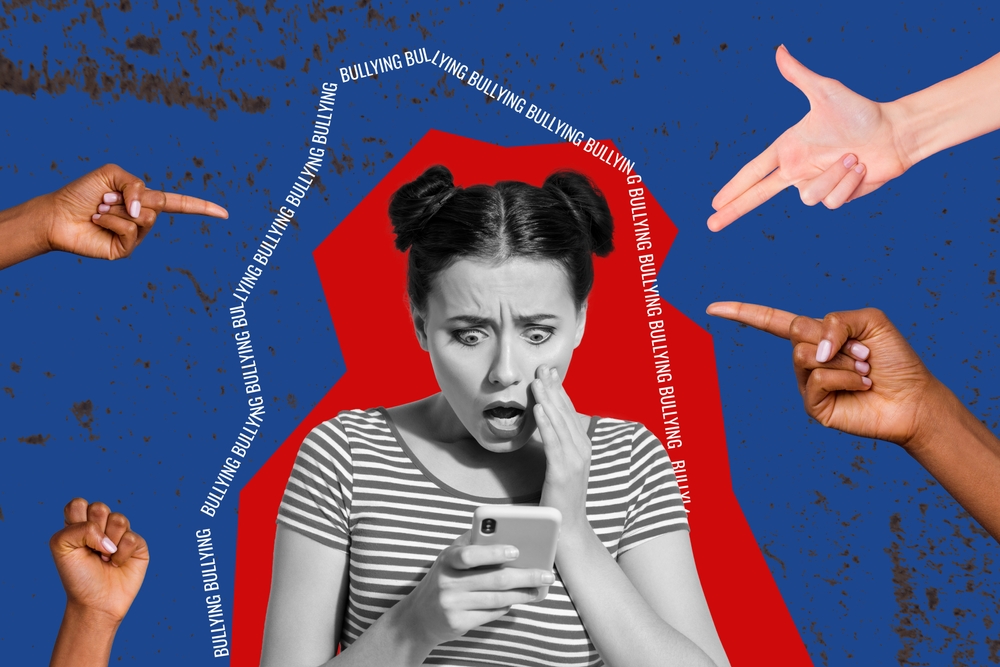AI Vs. Cyberbullying: Protecting The Vulnerable

In a world where the shadows of cyberbullying loom large, a silent guardian has emerged, and it's not your conventional hero, it's AI.
Samiksha Jain November 11th, 2023

Share on LinkedInShare on Twitter
In the quiet town of Bayville, New Jersey, a tragedy unfolded on February 3. A young soul, just 14 years old, named Adriana Kuch, found herself entangled in a nightmare that no one her age should ever experience. It all began in the halls of her high school when she became the target of a vicious physical assault.
The torment didn’t stop there; it was all recorded and, unimaginably, shared on TikTok. What followed was a storm of cyberbullying that engulfed Adriana, pushing her to a decision that no one should ever have to make.
As the days passed, four students found themselves facing charges, and the school district’s superintendent took the step of resignation. Adriana’s family, in their grief, connected the dots and attributed her tragic end to the ruthless cyberbullying that followed the assault. Others, within the community, cast a pointed finger at the school’s leadership, holding them accountable for allowing a culture of bullying to persist.
But it’s not just about Adriana. This heart-wrenching tale is one of many similar stories, each a stark warning sign that demands our attention. In an era where we find connection through screens and where friendships are crafted through likes and shares, the dark shadow of cyberbullying has become an all-too-common plague.
Victims, both young and old, from diverse backgrounds, have found themselves under barricades. Their digital safe havens have turned into battlegrounds, and the toll it takes on their self-esteem and mental well-being is immeasurable.
Yet, amidst this digital darkness, a glimmer of hope emerges. A hero has stepped onto the stage, one who doesn’t wear a cape or wield a sword but possesses a power greater than any human. They call it artificial intelligence, or AI for short. With the rise of AI, a new dawn has arrived, a time when the digital world has found its defender.
The Rising Threat of Cyberbullying

Cyberbullying is an escalating issue, affecting a significant number of individuals, including over 60% of kids and approximately 40% of adults, with the situation expected to worsen.
In the past, bullying used to be a primarily face-to-face occurrence. However, today’s bullies have the power to reach their targets constantly through platforms like social media, texting, emails, and online games. This digital era has given rise to a distressing mix of cyberbullying, encompassing text, audio, images, and videos.
According to a survey, children who fall victim to online bullying, especially in middle school, face nearly double the risk of contemplating self-harm. The situation has deteriorated over time, as the number of people encountering physical threats and sexual harassment online has doubled since 2014.
Remarkably, a significant 75% of cyberbullying occurs on Facebook, marking it as the primary platform for such misconduct. In contrast, other social media platforms like Twitter, Instagram, YouTube, and Snapchat witness significantly fewer cyberbullying incidents, with 25% or fewer of cases traced back to these platforms.
“Today, social media is very powerful due to its reach and affordability. With Internet connectivity becoming better, access to social media is also increasing exponentially. People are free to express their ideas and views freely and openly. One wrong comment and we have seen the kind of pressure an individual is put through,” said Ambarish Kumar Singh, Chief Information Security Officer (CISO) at Godrej & Boyce.
The Profound Impact of Cyberbullying

The consequences of cyberbullying can be profoundly damaging, both psychologically and emotionally. Victims often experience heightened stress, anxiety, and depression due to relentless online harassment, as Singh, points out: “In the digital space, whatever we do remains alive in some form or the other forever, even after deletion. This can affect an individual mentally, physically, and emotionally as well.”
In severe cases, cyberbullying can lead to suicidal ideation, with victims feeling overwhelmed by the negative impact on their mental well-being. Additionally, the constant connectivity to digital devices, paired with the anonymity that online platforms provide, can make the torment unrelenting and deeply distressing.
Amitabh Bhardwaj, Joint Director of IT and Cyber Security, has highlighted key patterns and difficulties associated with cyberbullying, which pose a significant threat to online safety. These encompass heightened digital engagement, particularly among youth, which increases their vulnerability to online harassment.
The use of anonymity and false identities by cyberbullies complicates the identification and mitigation of their actions. Policymakers and online platforms face substantial challenges in establishing and enforcing effective regulations to prevent cyberbullying, compounded by the monumental task of monitoring extensive online content.
These consequences underscore the urgent need to address and prevent cyberbullying in our increasingly digital world.
AI to the Rescue: The Unsung Hero in Tackling Cyberbullying
In a world where the shadows of cyberbullying loom large, a silent guardian has emerged, and it’s not your conventional hero. Artificial intelligence (AI), the unsung hero, is quietly but powerfully stepping in to tackle the relentless wave of online harassment. With its vigilant algorithms and tireless watchfulness, AI is rewriting the narrative, standing as a beacon of hope for countless victims of cyberbullying.
“By leveraging the capabilities of NLP, ML, DL, AI-powered chatbots and AI-driven analytics, organizations and platforms can create safer online environments and provide timely support to those affected by cyberbullying.AI technologies collectively contribute to a more robust and comprehensive approach to identifying and preventing cyberbullying in real-time,” said Bhardwaj.
Bhardwaj highlights the multifaceted strengths of AI, from NLP’s pattern recognition in text and speech to ML’s algorithmic precision in identifying cyberbullying behavior and at-risk individuals. DL’s data analysis prowess enhances the precision of detecting cyberbullying instances and vulnerable targets, while AI-powered chatbots offer constant guidance and aid in reporting abusive content. Additionally, AI-powered analytics provide insights into the evolving landscape of cyberbullying, shaping more effective prevention and intervention strategies.
Singh further highlights the pivotal role of Machine Learning in training models to detect cyberbullying across digital platforms. “Machine learning has become a very powerful tool today, which can be trained on various models to detect cyberbullying in the digital space. ML algorithms can be trained to detect cyberbullying behavior on social media, messaging apps, and other digital platforms,” Singh said.
He further emphasizes the need for users to exercise mindfulness when posting online, emphasizing the importance of considering what, why, and how we share content.
On the other hand, Neal Quinn, Head of Cloud Security Services, North America at Radware, highlights AI’s capacity to enhance the accuracy and reach of systems for spotting abusive online behaviors earlier.
“AI can be used to improve the accuracy and reach of systems so you can spot abusive online behaviors earlier. For instance, AI can be used to automate image analysis and correlate crowd behaviors across social media platforms. This combination makes it easier and quicker to do a wide and deep search for evidence of bullying and then act on it. Likewise, concerned human operators can use emerging tools like Generative AI to quickly research suspected abuses in some cases. This can augment more targeted searches of social media posts to find incidents of bullying,” Quinn explained.
AI Ethics and Challenges in the Fight Against Cyberbullying
The use of Artificial Intelligence (AI) and Machine Learning (ML) to identify cyberbullying presents a range of challenges and ethical dilemmas. A survey by the Capgemini Research Institute revealed that cybersecurity professionals are concerned about the opacity of AI and ML algorithms, which makes it difficult to understand how they arrive at their decisions, posing a significant obstacle to implementing these technologies in cybersecurity strategies.
Privacy and security are central concerns when it comes to AI. AI systems process massive amounts of data, and there’s a risk of mishandling this information, whether through deliberate breaches or unintentional leaks. This mishandling could lead to the exposure of sensitive data, potentially resulting in identity theft, financial fraud, and other forms of misuse.
Another worry is the susceptibility of AI systems to hacking and manipulation. As AI systems become more sophisticated and autonomous, the risk of cyberattacks rises. These attacks could allow malicious actors to gain control over AI systems, causing them to make harmful decisions for individuals or society.
In addition to these technical security issues, ethical questions arise concerning AI decision-making. AI’s ability to process vast datasets means it can make decisions that exhibit bias or discrimination. This could lead to the unfair treatment of certain individuals or groups, further aggravating existing social inequalities.
To address these concerns, it’s vital to establish a robust framework of privacy and security principles in AI development. This framework should include measures for safeguarding personal data, such as encryption and secure data storage, as well as protocols for handling data breaches and cyberattacks. Furthermore, transparency and accountability are essential in AI systems’ decision-making processes, and mechanisms must be in place to detect and rectify biases in cyberbullying detection algorithms.
The Path Forward: Uniting Against Cyberbullying
Advancements in AI technology have brought us to a pivotal moment in this fight, offering a robust and comprehensive approach to identifying and preventing online harassment. However, AI alone cannot solve this issue; it takes a community to make a change. We call upon stakeholders, including schools, parents, social media platforms, and policymakers, to join this fight.
“In the battle against cyberbullying, several critical factors must be considered. This includes the implementation of rigorous regulations on social media platforms, the widespread promotion of digital literacy and online safety education, the nurturing of a culture marked by empathy and respect in all online interactions, the encouragement of open and honest communication between parents, educators, and children, and the provision of accessible mental health support services for those affected by cyberbullying,” opined Bhardwaj.
User empowerment and digital literacy are our best defenses against the shadows of cyberbullying, for every interaction matters in the digital world. Together, let’s work towards a hopeful vision where the online environment is safer, kinder, and more inclusive, and where a silent hero called AI continues to stand guard, protecting us from the relentless wave of cyberbullying.





